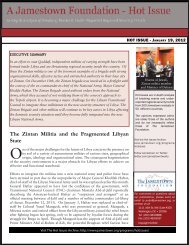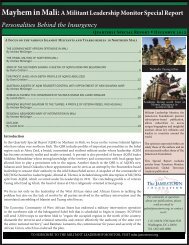By Brian Glyn Williams - The Jamestown Foundation
By Brian Glyn Williams - The Jamestown Foundation
By Brian Glyn Williams - The Jamestown Foundation
Create successful ePaper yourself
Turn your PDF publications into a flip-book with our unique Google optimized e-Paper software.
In the seventeenth century, troops serving under Montecuccoli invented the bayonet to help them<br />
overcome the Sultan's cavalry forces. 150 Austria's musketeers were thus rendered far more effective for they no<br />
longer needed to retreat behind a wall of pikes at the approach of Sultan's riders.<br />
<strong>The</strong> advantages given to the Austrians by these advances were definitely significant, but not as telling as<br />
might seem. <strong>The</strong> Tatars' maneuverability often rendered the Habsburg's cannon useless and the Tatars'<br />
bow was still used with deadly effect against massed troops. It is also interesting to note that the Austrians<br />
made little progress in developing tactics to overcome the Tatars' raiding skills despite their<br />
improvements in tactics on the battlefield.<br />
In the Austrian countryside, the Khan's raiders were able to move with a freedom that must have surprised the<br />
Tatars used to the elaborate defense systems of Poland and Russia. <strong>The</strong> Austrian provincial aristocracy<br />
proved to be especially inept in its attempts to halt the forays of the Tatar akinji. <strong>The</strong>y, unlike their<br />
counterparts in Poland and Russia, were inexperienced in dealing with a highly mobile steppe foe and<br />
often fled their estates at the approach of an Ottoman army. 151 Signal fires, warning bells, and defense patrols that<br />
required higher organization were often rendered ineffective by a lack of local organization. <strong>The</strong> rural<br />
population was thus left at the mercy of the Turco-Tatar raiders who could engage in raiding with relative<br />
ease. Barker notes that:<br />
Although the Muslims were for the most part only lightly equipped—the Tatars lacked<br />
even firearms—the population virtually paralyzed by fear, offered little resistance,<br />
preferring precipitate flight or meek submission. 52<br />
<strong>The</strong>re were of course exceptions. On several occasions local castles held off Tatar assaults with relative<br />
ease, for the plunder hungry akinji were reluctant to waste their time attacking fortified positions. <strong>The</strong><br />
most interesting case of local resistance to the marauders occurred in Lilienfeld, in 1683, when a Cistercian<br />
monk managed to organize a surprisingly efficient peasant defense force. <strong>The</strong> naked corpses of Turkish and<br />
Tatar raiders slain by the monk's men were displayed along the country roads in this vicinity to warn off other<br />
raiders. 153<br />
In the border regions, where Turkish raids were more common, the local resistance was of course better<br />
organized. Villages here were placed on hills and surrounded by walls and castles were more frequent. This<br />
region was, however, the exception and most of Austria was left practically defenseless.<br />
<strong>The</strong> akinjis' raids were especially destructive in Lower Austria where a document written in 1689 claims that<br />
as many as 500,000 people were killed or enslaved during a single campaign. 154 Barker makes the claim<br />
that this region "did not fully recover from its wounds until the middle of the eighteenth century." 155 It<br />
can thus be seen that the Austrians' poor defensive planning often went a long way in facilitating Tatar raids in<br />
a country that admittedly was not well suited to the Tatars' style of warfare.<br />
During a siege, this ability to move throughout the Austrian countryside on foraging missions was of<br />
great assistance to the Ottomans. <strong>The</strong> Khan's raiders greatly facilitated Ottoman siege operations by<br />
supplying the army with the important slave labor needed to construct the Turks' massive siege works.<br />
<strong>The</strong>y could also be counted on to gather lumber and capture food supplies for the preoccupied siege<br />
forces. <strong>The</strong>ir operations provided additional help to the main army by hindering enemy communications<br />
and causing confusion among the terrorized population.<br />
36
















